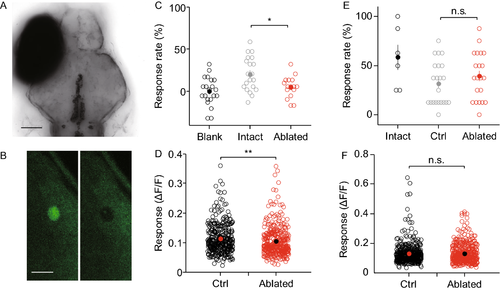Fig. 4
- ID
- ZDB-FIG-190709-9
- Publication
- Yin et al., 2018 - Optic tectal superficial interneurons detect motion in larval zebrafish
- Other Figures
- All Figure Page
- Back to All Figure Page
|
SINs are crucial for prey capture but not looming-evoked escape. (A) Confocal image of a 7 dpf larva with ipsilateral eye removed. Scale bar, 100 μm. (B) SIN before (Left panel) and after (Right panel) laser ablation. Soma is destroyed and cell debris is visible. Scale bar, 10 μm. (C) Prey capture reduced in SIN ablated larvae (n = 16) relative to control (n = 20, P = 0.0134, Student’s t-test). Blank indicates no fish control. (D) Prey-like moving dot stimulation (3°) evoked response in PVNs reduced in SIN ablated larvae (n = 348 from 13 larvae) relative to control (n = 362 from 15 larvae, P = 0.0011, Wilcoxon rank-sum test). (E) Looming evoked escape unaffected in SIN ablated larvae (n = 21) relative to control (n = 22, P = 0.3132, Wilcoxon rank-sum test). Intact fish serve as control. (F) Looming evoked tectal responses unaffected in SIN ablated larvae (n = 392 from 6 larvae) relative to control (n = 414 from 7 larvae, P = 0.9004, Wilcoxon rank-sum test) |

